This October 2016 exhibit features two artists who are making their inaugural appearance at The Dolphin Gallery, sculptor David Comfort and intarsia wood artist Tim Windsor. The opening night reception is on Saturday, October 1, 2016 from 5 to 7 p.m., and the show runs through Thursday, November 10, 2016.
David Comfort
Beginning many years ago as a furniture maker, the artistic career of David Comfort has evolved in a variety of directions. This show will feature his wood and bone sculpture pieces, but he has eclectic interests that include furniture design and construction, painting, and writing fiction and non-fiction works as well as posting blogs.
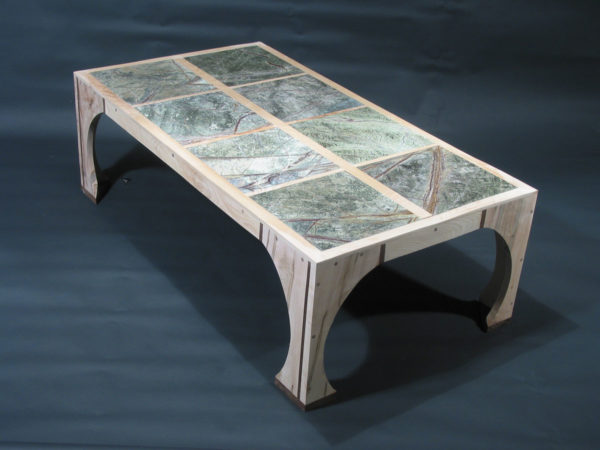
For Comfort, unadorned bone provides striking possibilities because of its sensuous shapes, it subtle hues, and its distinctive patinas. He gathers the seasoned remains of cattle and deer from the wild. He will cut, carve, reshape, burnish and sand each piece into imaginary figures that evoke a special response in the viewer.
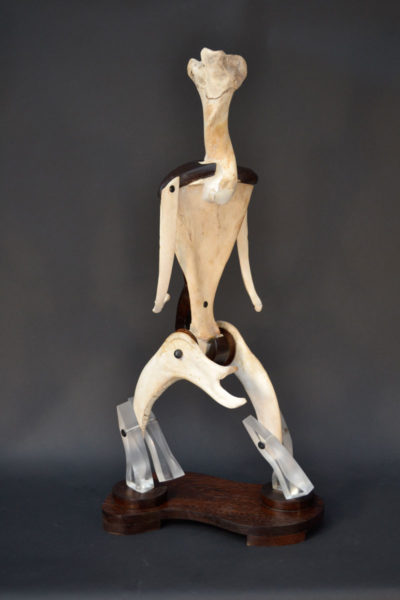 Whether Comfort is working in wood or bone his sculptures share the same influences. African primitive, cubist and biomorphic inspirations all contribute to his vision. Using wood, particularly exotic hardwoods, came naturally from working with these materials to build custom designed furniture pieces. From there he began experimenting with acrylic glass and bone.
Whether Comfort is working in wood or bone his sculptures share the same influences. African primitive, cubist and biomorphic inspirations all contribute to his vision. Using wood, particularly exotic hardwoods, came naturally from working with these materials to build custom designed furniture pieces. From there he began experimenting with acrylic glass and bone.
A pelvis may become a honeycombed head, a jawbone or rib may become a leg, and a shoulder blade may become a torso, all joined with orthopedic techniques developed through much experimentation and experience. Finally, he sometimes chooses to incorporate hardwoods or color-rich acrylic to complement the weathered whites of the bone.
Comfort says, “I regard my own work as a synthetic. Primitive to the extent that it tends to the animistic. Medieval to the extent that it tends to the hierarchical, allegorical, religious. Expressionist to the extent that it is hermetic, violent, extremist. Surrealist to the extent that it is hallucinatory, rooted in the Unconscious. And abstract to the extent that it is metaphysical.”
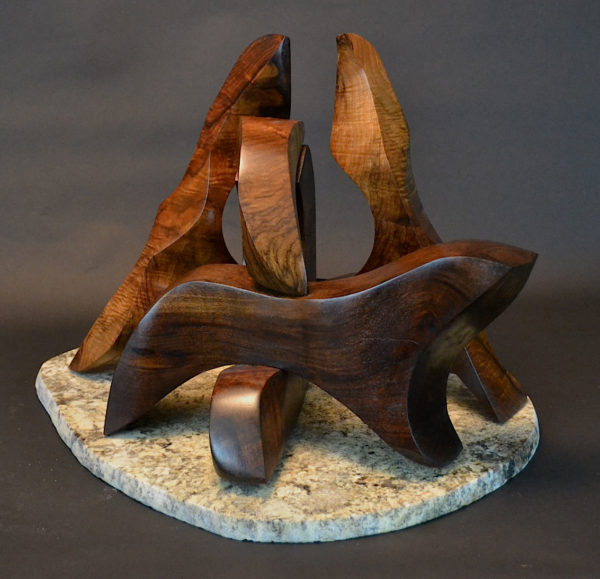
To learn more about the artist, visit the virtual galleries of his paintings, sculptures, and furniture on his website – davidcomfort.org. There one can also find excerpts from both his non-fiction and fiction publications, as well as references to his published articles and blogs. The site chronicles his numerous solo and group art shows.
Tim Windsor
The term “intarsia” is perhaps familiar only to a select group of woodworkers, but for Timothy Windsor, the process it describes unlocked a creative outlet that has captivated him for many years. Dating back to 16th century Italy, intarsia is the art of making wood mosaics that fit in a puzzle-like pattern to create a three-dimensional effect.
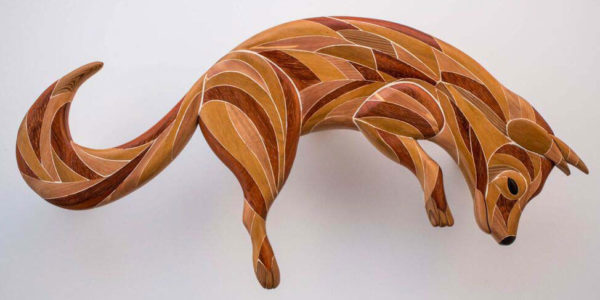
The painstaking process Windsor employs begins with making drawings that may involve redrawing designs over several weeks to best overcome the limitations on shapes, curves and angles that his materials may present. Once he is satisfied with the design he makes up to ten copies which are cut out and pasted to carefully prepared pieces of wood.
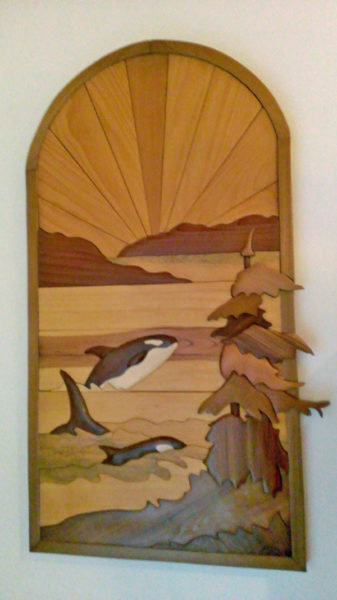
Each piece is precisely cut on a special scroll saw so that they all will fit together properly. For a 12” by 16” design this step can take from 10 to 20 hours depending on the hardness and grain of the wood used. Next the pieces are sculpted using a sanding drum before being shaped with knives, sandpaper, or a rotary hand tool. Lastly, the segments undergo a final sanding, a finish is applied, and the final product is glued to a backing material.
The entire process can take from 60 to 80 hours to complete. Windsor worked on one example in this show for eight years. He points out, “I never use stains or dyes to change the wood’s natural beauty. The entire process cannot be rushed or the results will be disappointing.”
Since his father was a woodcarver, Windsor tried doing that as an avocation, but it never held his interest for long. One day he learned about intarsia through an internet search and stuck with it. He originally did it for fun, but others encouraged him to share his work. Known locally as “the puzzle guy,” he is still amazed to find his pieces hanging proudly in other people’s homes.
Originally from Oregon, he moved to California for a career in law enforcement. After retiring as a Sergeant with the Tracy Police department, he and his wife moved to the Sonoma coast where they frequently vacationed. Windsor also operates the Stewarts Point Post Office and enjoys visiting with customers and travelers that stop by.

 Gualala Arts Promoting public interest and participation in the arts since 1961
Gualala Arts Promoting public interest and participation in the arts since 1961